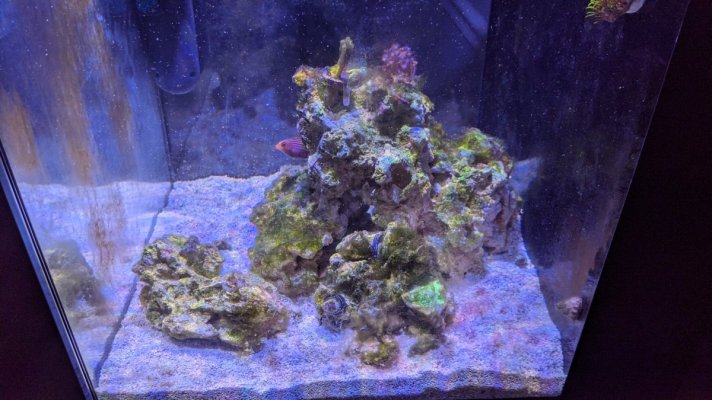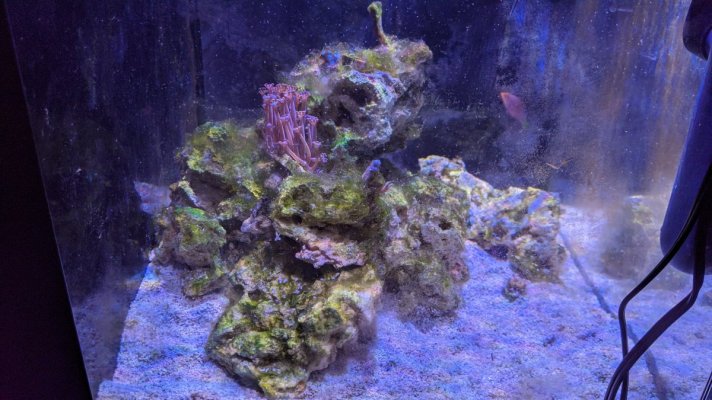I've been battling what I believe are dinoflagellates in my Waterbox 20 cube that was set up about 3 months ago. This saga kind of started with some nasty GHA at the beginning of November. I started using Vibrant with my weekly waterchanges and that knocked that out in about a week, but shortly after these brown snotty looking dinos started showing up. They make microfiber strands longer than 1" and create insane amount of bubbles towards the evening time, about 3 or 4 hours before the lights go out.
Trochus snails have started dying and the corals were beginning to get tangled in some of the strands so I started doing some regular heavy duty scrubbings and siphoning and replacing filter pads, in addition to adding a healthy amount of pods (tiger and apex) and began dosing 40 drops of Phytofeast Live daily. It seemed to have a small impact at first, but even after manual removal they are already starting to come back within a day. I also attempted a reduced photo period that didn't seem to work, and also attempted to remove the white light spectrum on my AI prime HD which also didn't appear to work.
Tried a 3-day blackout starting on 12/15 but did not completely block light using a barrier as the tank is in my basement which stays pretty dark most of the time. It had a huge impact on the dinos, by the time it was done they looked like they were eradicated; but sure enough I started seeing signs of them again three days after the blackout ended. The coral and fish did not appear to be too happy with the blackout, I'm hesitant to try it again even though it seemed to be the most effective thing I've tried so far. If I do go that route I'll have to set up a hospital tank to hold the rest of the livestock and then do a 10-day blackout.
Some examples from pics I just took tonight:



The tank is currently sitting at 78.5°F, 1.025 SG, and a pH of 8.42. Nitrate reads ~1 ppm and Phosphate 0.25 ppm. On 12/19 I bought and installed a UV sterilizer (the 9 watt Green Killing Machine), it's been running nonstop since then. I'm thinking at this point my best bet is to stop the weekly water changes and stop dosing vibrant in an attempt to allow some other algae to outcompete the dinos; then try introducing a ton more copepods over the course of a few days while continuing my daily dose the Phytofeast Live.
Anyways, today my $15 Amazon microscope showed up and I had a fun couple of hours exploring all the critters I could find. I pulled out a decent sample of the dinos right from the rock surface where all the bubbles were forming and got a couple pretty good videos of them.
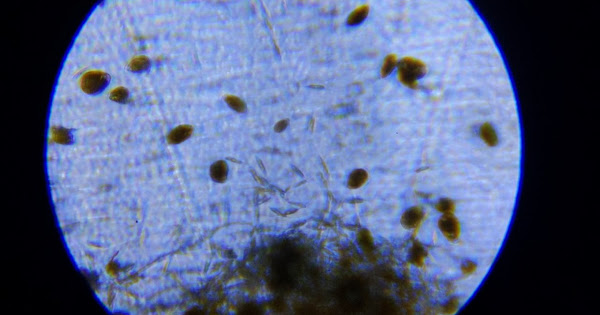
 photos.app.goo.gl
photos.app.goo.gl
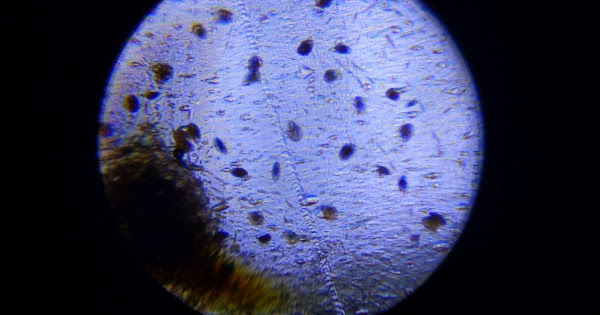
 photos.app.goo.gl
photos.app.goo.gl
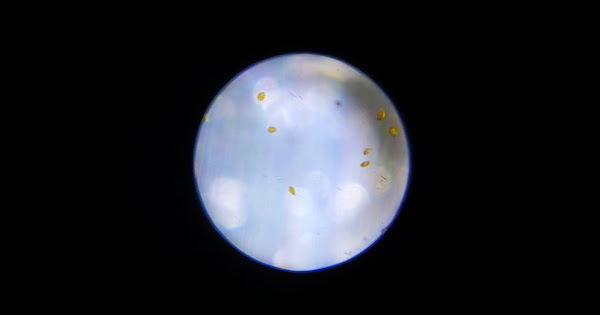
 photos.app.goo.gl
photos.app.goo.gl
As a side note... I got a couple of other cool microscope videos of critters, can anyone identify this: https://photos.app.goo.gl/yNF8a7M2Bm2AVkMq9
or this: https://photos.app.goo.gl/Bakj6N3nzp4raLn19
Thanks!!!
Trochus snails have started dying and the corals were beginning to get tangled in some of the strands so I started doing some regular heavy duty scrubbings and siphoning and replacing filter pads, in addition to adding a healthy amount of pods (tiger and apex) and began dosing 40 drops of Phytofeast Live daily. It seemed to have a small impact at first, but even after manual removal they are already starting to come back within a day. I also attempted a reduced photo period that didn't seem to work, and also attempted to remove the white light spectrum on my AI prime HD which also didn't appear to work.
Tried a 3-day blackout starting on 12/15 but did not completely block light using a barrier as the tank is in my basement which stays pretty dark most of the time. It had a huge impact on the dinos, by the time it was done they looked like they were eradicated; but sure enough I started seeing signs of them again three days after the blackout ended. The coral and fish did not appear to be too happy with the blackout, I'm hesitant to try it again even though it seemed to be the most effective thing I've tried so far. If I do go that route I'll have to set up a hospital tank to hold the rest of the livestock and then do a 10-day blackout.
Some examples from pics I just took tonight:
The tank is currently sitting at 78.5°F, 1.025 SG, and a pH of 8.42. Nitrate reads ~1 ppm and Phosphate 0.25 ppm. On 12/19 I bought and installed a UV sterilizer (the 9 watt Green Killing Machine), it's been running nonstop since then. I'm thinking at this point my best bet is to stop the weekly water changes and stop dosing vibrant in an attempt to allow some other algae to outcompete the dinos; then try introducing a ton more copepods over the course of a few days while continuing my daily dose the Phytofeast Live.
Anyways, today my $15 Amazon microscope showed up and I had a fun couple of hours exploring all the critters I could find. I pulled out a decent sample of the dinos right from the rock surface where all the bubbles were forming and got a couple pretty good videos of them.
New video by Bill Pankau
 photos.app.goo.gl
photos.app.goo.gl
New video by Bill Pankau
 photos.app.goo.gl
photos.app.goo.gl
New video by Bill Pankau
 photos.app.goo.gl
photos.app.goo.gl
As a side note... I got a couple of other cool microscope videos of critters, can anyone identify this: https://photos.app.goo.gl/yNF8a7M2Bm2AVkMq9
or this: https://photos.app.goo.gl/Bakj6N3nzp4raLn19
Thanks!!!








